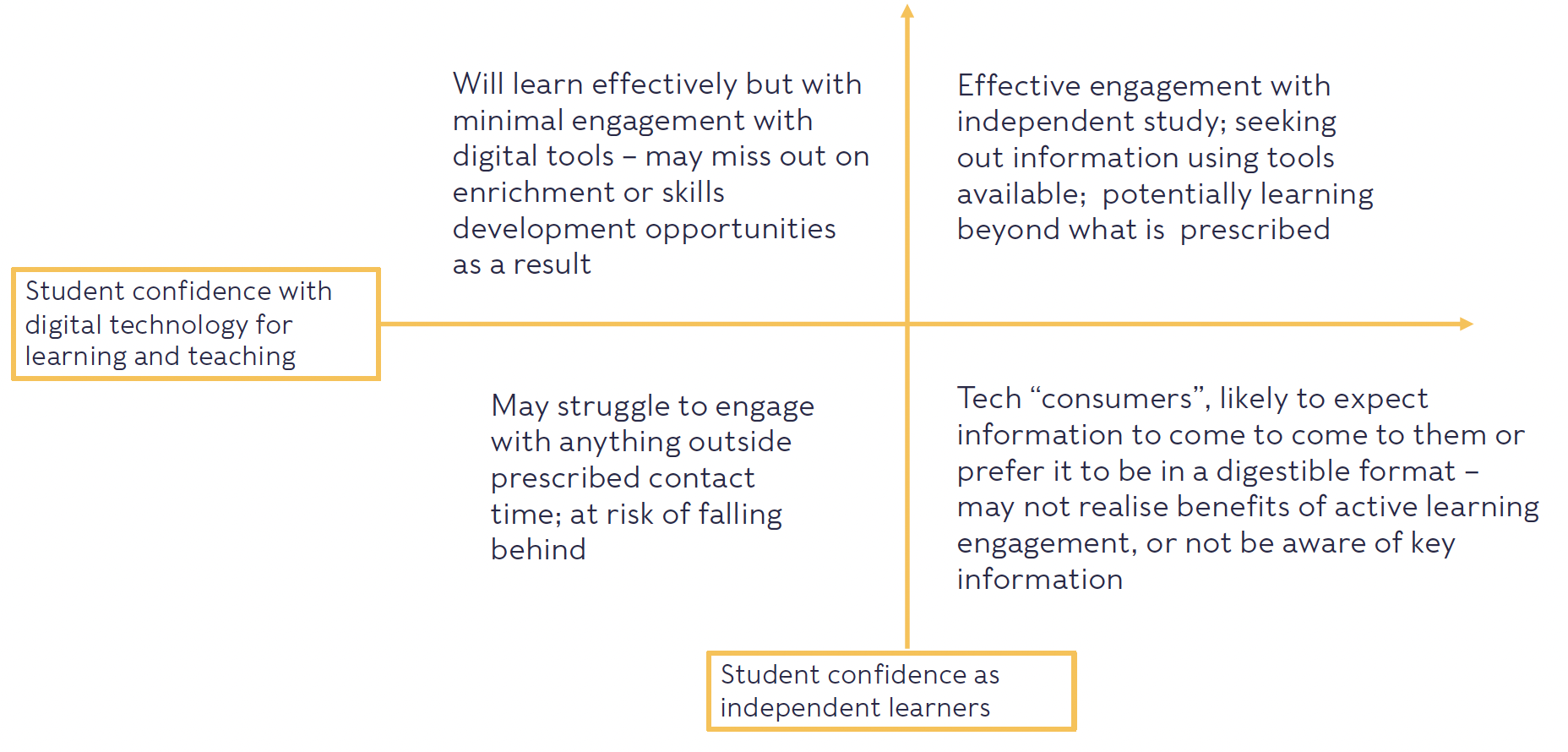Respondents to the Wonkhe/Kortext survey of educators were not especially confident that students understand what is expected of them in their engagement with digitally enhanced learning, teaching, and academic support. When asked to rate their degree of confidence on a five point scale only one in five (20 per cent) rated their confidence level at four or five.
Asked to explain why, there was clearly variation in the extent to which respondents felt that their institutions had clear expectations of students, the extent to which these had been well communicated, and the extent to which students had absorbed these expectations.
Some respondents said that expectations were very clear and well-communicated:
It is embedded within my courses from open day to graduation. Students need to be supported in what can be a difficult and challenging journey. Academic, post-92 university
Others said that they did not think their institution had clear expectations or that there is a lot of variation in expectation by course or in relation to academics’ varying degrees of enthusiasm for digital technology. Where this relates to the subject discipline this is very understandable, but one of the consequences seems to be that where these matters are left solely to course or programme teams to determine there is not consistency of understanding of what a baseline digital skill set for learning in higher education might be or whether there is a core set of digital capabilities students should graduate with.
Another theme was the complexities of digital infrastructure – with multiple platforms and communication mechanisms, the potential for overwhelm is high, and time-pressured students may struggle to give the bandwidth required to navigate these.
I think all students use digital tools differently with some engaging in the bare minimum in order to complete their study. There are too many resources, which might make it difficult for students to navigate or understand what to use, and how. Learning and teaching professional, pre-92 university
Not embedding clear expectations for students’ digital engagement potentially has important consequences for student success. A lot of responses explored the intersection between a very mixed picture of students’ capabilities and confidence with digital technology, and students’ core motivations and degree of independence as learners. Post-Covid, while academics might use digital tools as part of in-person teaching, arguably the bulk of students’ digital learning engagement is in their independent study. Simply knowing how to use the various tools and platforms available is not sufficient – students must develop the skills to learn independently.
For students who are motivated to seek out information, read beyond the prescribed texts, and explore topics that interest them, the digital world offers incredible learning opportunities. For those who are less confident in either digital engagement or in independent learning, they may miss out on some core aspects of their high education experience. And those who are confident in neither are at the highest risk of falling behind, even if they are consistently showing up to scheduled in-person learning.
The below diagram gives a visual representation of how these interrelated skill sets might shape students’ learning experience and what the outcomes might be. Thinking about how these areas of capability interrelate and what support students may need could help to unlock some of the questions about how flexible learning should be, or what students may need to be effective in self-directed independent study.

Students need joined up thinking about how digitally enhanced teaching, digital skills, and the physical campus can support their learning
Bethan Dudas, director of membership services, Anglia Ruskin Students’ Union
The number one technology-related complaint we hear from students at ARU is about academic staff not putting their power point slides up on our VLE. That’s when they’re not trying to locate a plug socket to charge their device, or battling the occasionally patchy wifi across our several campuses. And these issues are hardly distinctive to our institution.
That’s not to say that there’s not some fantastic innovation going on. We saw some incredible practice during Covid, for example our school of nursing created a virtual ward to address the shortage of student placement opportunities and give students a lifelike experience of working in the health service. This is one of many examples of digital innovation going on in different subjects and courses. So we know that it’s possible to inspire and engage students in learning in novel ways using technology. ARU has also been very effective in tackling digital inequality through our laptop loan and voucher scheme so that no student should ever be unable to complete their academic work through lack of access to hardware.
Yet working in student representation I’m often struck by what can feel like a gulf between the lofty aspirations of institutional learning and teaching agendas and the often mundane realities of students’ lives. In engaging with technology we all want students to be digitally capable, benefitting from cutting edge innovations. But frequently overloaded students just want to know they are on track with learning and know they can easily find information and resources when they need them. We need big ideas to help inspire a vision of what the future might look like – but as universities increasingly turn to technology to support learning, teaching, and student support at scale, it’s vitally important that students don’t get left behind.
There can also be a gulf between how students use technologies like social media in their personal lives, and whether they feel they can mobilise those skills in their learning and teaching. Engagement with social media platforms involves creativity, crafting impactful messages, and moderate technical capability. Yet students don’t always see these as transferable skills that they could hone and develop as part of their university experience.
I wouldn’t necessarily argue that students’ learning and teaching experience should be just like their consumer experiences on platforms like Netflix – it’s important that students are able to be thoughtful and critical about how they are using technology to enhance their learning and not merely see their learning as an extension of their lives as digital consumers.
But I do think there should be some joined-up thinking about what’s expected of academics in terms of using digital technology in learning and teaching, what skills students will need to be able to engage with that effectively – especially in establishing good practice around building skills for independent learning and their future employability – and the ways that the physical estate of the university supports those aspirations. It’s all very well to build use of generative AI into classroom settings – but not if there aren’t sufficient charging points in those classrooms to enable students to participate, or readily available sources of advice and support for those students who need a boost to their confidence or skills to engage with digital technologies.
Providing students with access to devices and giving them a crash course on accessing the VLE and other university-mandated platforms is a good start, but universities are going to have to go further, in partnership with students, to really map out a holistic student support journey for digitally enhanced learning and teaching.
This article is published in association with Kortext as part of a suite on the theme of universities deploying technology for learning, teaching, and student success. You can download the full report of the survey findings and leaders’ insight over on Kortext’s website here.















Thanks for the laugh!
Joined up thinking, in a University, that’s a cracker.
The ONLY way to make this work is to involve as many stakeholders as possible very publicly, including the Trade Unions and Students Union and not leave it to the bean counters and I.T. department under the auspice’s of a DVC. The removal of hardwired telephony and switching exclusively to ‘Teams’ telephony without any emergency facility is a perfect example of how this goes if you do (the University of Southampton’s latest I.T. imposed savings fuster cluck).